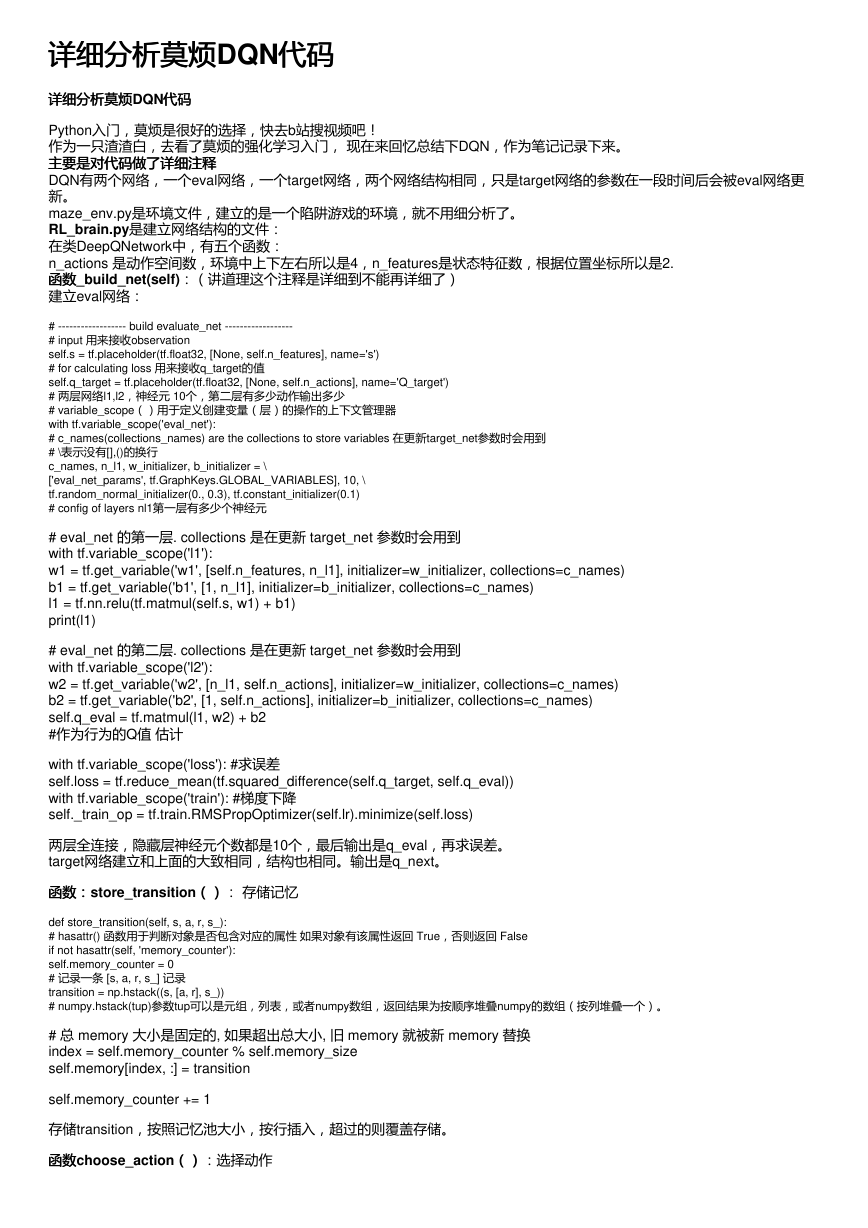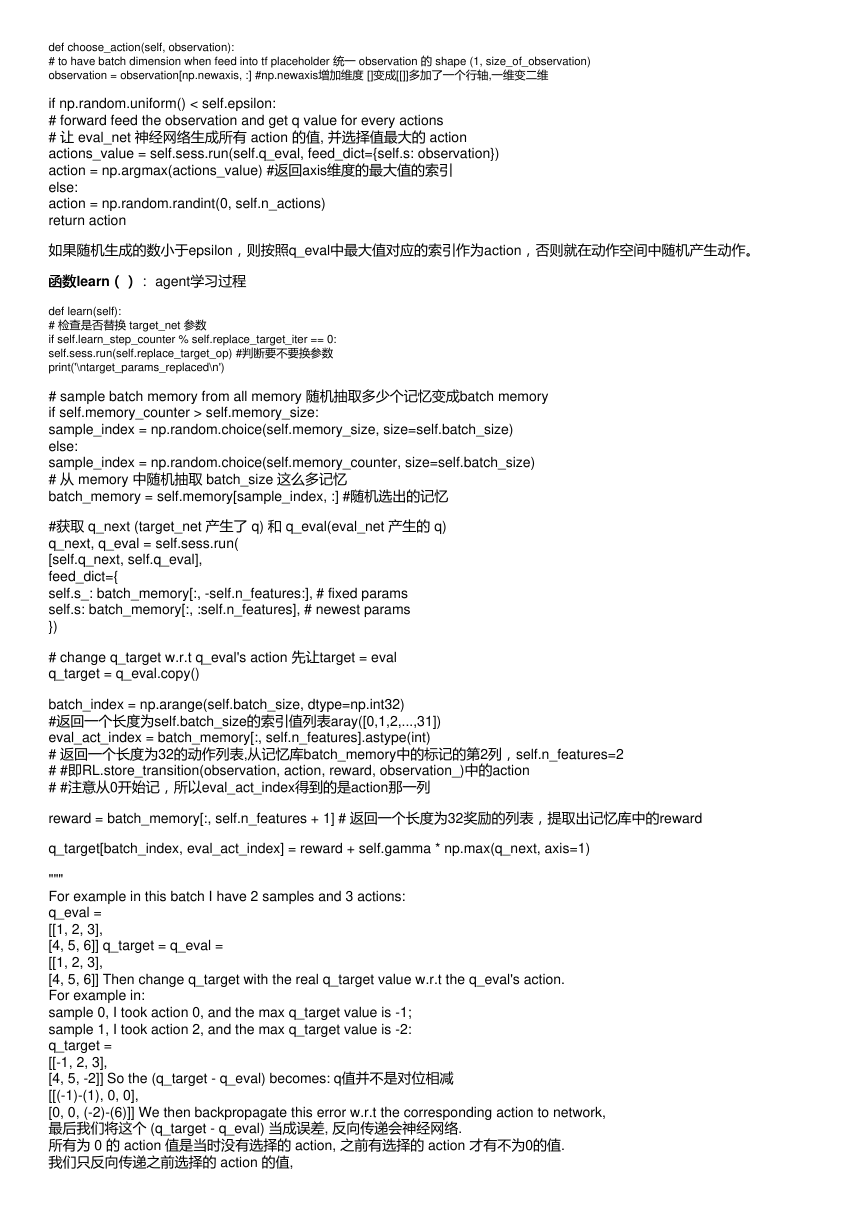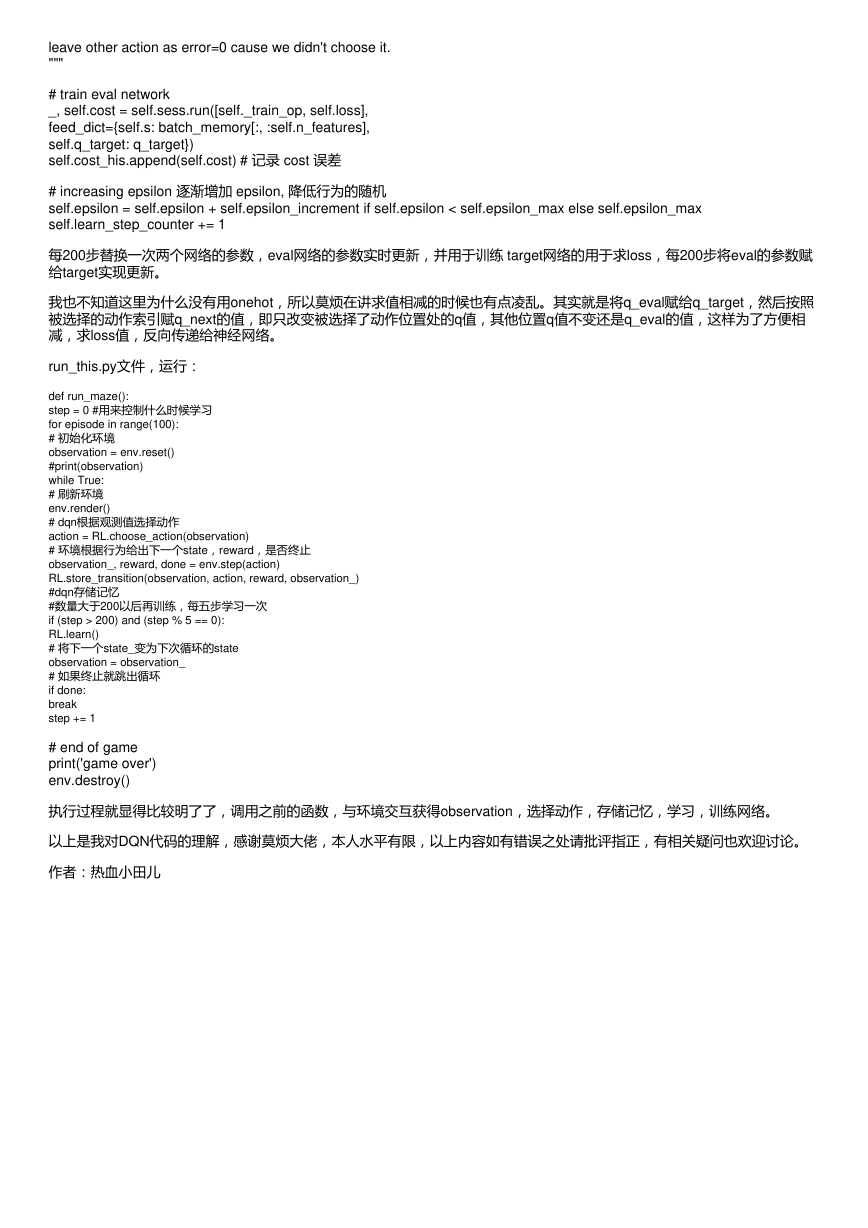详细分析莫烦DQN代码代码
详细分析莫烦
详细分析莫烦DQN代码代码
详细分析莫烦
Python入门,莫烦是很好的选择,快去b站搜视频吧!
作为一只渣渣白,去看了莫烦的强化学习入门, 现在来回忆总结下DQN,作为笔记记录下来。
主要是对代码做了详细注释
主要是对代码做了详细注释
DQN有两个网络,一个eval网络,一个target网络,两个网络结构相同,只是target网络的参数在一段时间后会被eval网络更
新。
maze_env.py是环境文件,建立的是一个陷阱游戏的环境,就不用细分析了。
RL_brain.py是建立网络结构的文件:
在类DeepQNetwork中,有五个函数:
n_actions 是动作空间数,环境中上下左右所以是4,n_features是状态特征数,根据位置坐标所以是2.
函数函数_build_net(self):(讲道理这个注释是详细到不能再详细了)
建立eval网络:
# ------------------ build evaluate_net ------------------
# input 用来接收observation
self.s = tf.placeholder(tf.float32, [None, self.n_features], name='s')
# for calculating loss 用来接收q_target的值
self.q_target = tf.placeholder(tf.float32, [None, self.n_actions], name='Q_target')
# 两层网络l1,l2,神经元 10个,第二层有多少动作输出多少
# variable_scope()用于定义创建变量(层)的操作的上下文管理器
with tf.variable_scope('eval_net'):
# c_names(collections_names) are the collections to store variables 在更新target_net参数时会用到
# \表示没有[],()的换行
c_names, n_l1, w_initializer, b_initializer = \
['eval_net_params', tf.GraphKeys.GLOBAL_VARIABLES], 10, \
tf.random_normal_initializer(0., 0.3), tf.constant_initializer(0.1)
# config of layers nl1第一层有多少个神经元
# eval_net 的第一层. collections 是在更新 target_net 参数时会用到
with tf.variable_scope('l1'):
w1 = tf.get_variable('w1', [self.n_features, n_l1], initializer=w_initializer, collections=c_names)
b1 = tf.get_variable('b1', [1, n_l1], initializer=b_initializer, collections=c_names)
l1 = tf.nn.relu(tf.matmul(self.s, w1) + b1)
print(l1)
# eval_net 的第二层. collections 是在更新 target_net 参数时会用到
with tf.variable_scope('l2'):
w2 = tf.get_variable('w2', [n_l1, self.n_actions], initializer=w_initializer, collections=c_names)
b2 = tf.get_variable('b2', [1, self.n_actions], initializer=b_initializer, collections=c_names)
self.q_eval = tf.matmul(l1, w2) + b2
#作为行为的Q值 估计
with tf.variable_scope('loss'): #求误差
self.loss = tf.reduce_mean(tf.squared_difference(self.q_target, self.q_eval))
with tf.variable_scope('train'): #梯度下降
self._train_op = tf.train.RMSPropOptimizer(self.lr).minimize(self.loss)
两层全连接,隐藏层神经元个数都是10个,最后输出是q_eval,再求误差。
target网络建立和上面的大致相同,结构也相同。输出是q_next。
函数:函数:store_transition()(): 存储记忆
def store_transition(self, s, a, r, s_):
# hasattr() 函数用于判断对象是否包含对应的属性 如果对象有该属性返回 True,否则返回 False
if not hasattr(self, 'memory_counter'):
self.memory_counter = 0
# 记录一条 [s, a, r, s_] 记录
transition = np.hstack((s, [a, r], s_))
# numpy.hstack(tup)参数tup可以是元组,列表,或者numpy数组,返回结果为按顺序堆叠numpy的数组(按列堆叠一个)。
# 总 memory 大小是固定的, 如果超出总大小, 旧 memory 就被新 memory 替换
index = self.memory_counter % self.memory_size
self.memory[index, :] = transition
self.memory_counter += 1
存储transition,按照记忆池大小,按行插入,超过的则覆盖存储。
函数函数choose_action()():选择动作
�
def choose_action(self, observation):
# to have batch dimension when feed into tf placeholder 统一 observation 的 shape (1, size_of_observation)
observation = observation[np.newaxis, :] #np.newaxis增加维度 []变成[[]]多加了一个行轴,一维变二维
if np.random.uniform() < self.epsilon:
# forward feed the observation and get q value for every actions
# 让 eval_net 神经网络生成所有 action 的值, 并选择值最大的 action
actions_value = self.sess.run(self.q_eval, feed_dict={self.s: observation})
action = np.argmax(actions_value) #返回axis维度的最大值的索引
else:
action = np.random.randint(0, self.n_actions)
return action
如果随机生成的数小于epsilon,则按照q_eval中最大值对应的索引作为action,否则就在动作空间中随机产生动作。
函数函数learn()(): agent学习过程
def learn(self):
# 检查是否替换 target_net 参数
if self.learn_step_counter % self.replace_target_iter == 0:
self.sess.run(self.replace_target_op) #判断要不要换参数
print('\ntarget_params_replaced\n')
# sample batch memory from all memory 随机抽取多少个记忆变成batch memory
if self.memory_counter > self.memory_size:
sample_index = np.random.choice(self.memory_size, size=self.batch_size)
else:
sample_index = np.random.choice(self.memory_counter, size=self.batch_size)
# 从 memory 中随机抽取 batch_size 这么多记忆
batch_memory = self.memory[sample_index, :] #随机选出的记忆
#获取 q_next (target_net 产生了 q) 和 q_eval(eval_net 产生的 q)
q_next, q_eval = self.sess.run(
[self.q_next, self.q_eval],
feed_dict={
self.s_: batch_memory[:, -self.n_features:], # fixed params
self.s: batch_memory[:, :self.n_features], # newest params
})
# change q_target w.r.t q_eval's action 先让target = eval
q_target = q_eval.copy()
batch_index = np.arange(self.batch_size, dtype=np.int32)
#返回一个长度为self.batch_size的索引值列表aray([0,1,2,...,31])
eval_act_index = batch_memory[:, self.n_features].astype(int)
# 返回一个长度为32的动作列表,从记忆库batch_memory中的标记的第2列,self.n_features=2
# #即RL.store_transition(observation, action, reward, observation_)中的action
# #注意从0开始记,所以eval_act_index得到的是action那一列
reward = batch_memory[:, self.n_features + 1] # 返回一个长度为32奖励的列表,提取出记忆库中的reward
q_target[batch_index, eval_act_index] = reward + self.gamma * np.max(q_next, axis=1)
"""
For example in this batch I have 2 samples and 3 actions:
q_eval =
[[1, 2, 3],
[4, 5, 6]] q_target = q_eval =
[[1, 2, 3],
[4, 5, 6]] Then change q_target with the real q_target value w.r.t the q_eval's action.
For example in:
sample 0, I took action 0, and the max q_target value is -1;
sample 1, I took action 2, and the max q_target value is -2:
q_target =
[[-1, 2, 3],
[4, 5, -2]] So the (q_target - q_eval) becomes: q值并不是对位相减
[[(-1)-(1), 0, 0],
[0, 0, (-2)-(6)]] We then backpropagate this error w.r.t the corresponding action to network,
最后我们将这个 (q_target - q_eval) 当成误差, 反向传递会神经网络.
所有为 0 的 action 值是当时没有选择的 action, 之前有选择的 action 才有不为0的值.
我们只反向传递之前选择的 action 的值,
�
leave other action as error=0 cause we didn't choose it.
"""
# train eval network
_, self.cost = self.sess.run([self._train_op, self.loss],
feed_dict={self.s: batch_memory[:, :self.n_features],
self.q_target: q_target})
self.cost_his.append(self.cost) # 记录 cost 误差
# increasing epsilon 逐渐增加 epsilon, 降低行为的随机
self.epsilon = self.epsilon + self.epsilon_increment if self.epsilon < self.epsilon_max else self.epsilon_max
self.learn_step_counter += 1
每200步替换一次两个网络的参数,eval网络的参数实时更新,并用于训练 target网络的用于求loss,每200步将eval的参数赋
给target实现更新。
我也不知道这里为什么没有用onehot,所以莫烦在讲求值相减的时候也有点凌乱。其实就是将q_eval赋给q_target,然后按照
被选择的动作索引赋q_next的值,即只改变被选择了动作位置处的q值,其他位置q值不变还是q_eval的值,这样为了方便相
减,求loss值,反向传递给神经网络。
run_this.py文件,运行:
def run_maze():
step = 0 #用来控制什么时候学习
for episode in range(100):
# 初始化环境
observation = env.reset()
#print(observation)
while True:
# 刷新环境
env.render()
# dqn根据观测值选择动作
action = RL.choose_action(observation)
# 环境根据行为给出下一个state,reward,是否终止
observation_, reward, done = env.step(action)
RL.store_transition(observation, action, reward, observation_)
#dqn存储记忆
#数量大于200以后再训练,每五步学习一次
if (step > 200) and (step % 5 == 0):
RL.learn()
# 将下一个state_变为下次循环的state
observation = observation_
# 如果终止就跳出循环
if done:
break
step += 1
# end of game
print('game over')
env.destroy()
执行过程就显得比较明了了,调用之前的函数,与环境交互获得observation,选择动作,存储记忆,学习,训练网络。
以上是我对DQN代码的理解,感谢莫烦大佬,本人水平有限,以上内容如有错误之处请批评指正,有相关疑问也欢迎讨论。
作者:热血小田儿
�






 2023年江西萍乡中考道德与法治真题及答案.doc
2023年江西萍乡中考道德与法治真题及答案.doc 2012年重庆南川中考生物真题及答案.doc
2012年重庆南川中考生物真题及答案.doc 2013年江西师范大学地理学综合及文艺理论基础考研真题.doc
2013年江西师范大学地理学综合及文艺理论基础考研真题.doc 2020年四川甘孜小升初语文真题及答案I卷.doc
2020年四川甘孜小升初语文真题及答案I卷.doc 2020年注册岩土工程师专业基础考试真题及答案.doc
2020年注册岩土工程师专业基础考试真题及答案.doc 2023-2024学年福建省厦门市九年级上学期数学月考试题及答案.doc
2023-2024学年福建省厦门市九年级上学期数学月考试题及答案.doc 2021-2022学年辽宁省沈阳市大东区九年级上学期语文期末试题及答案.doc
2021-2022学年辽宁省沈阳市大东区九年级上学期语文期末试题及答案.doc 2022-2023学年北京东城区初三第一学期物理期末试卷及答案.doc
2022-2023学年北京东城区初三第一学期物理期末试卷及答案.doc 2018上半年江西教师资格初中地理学科知识与教学能力真题及答案.doc
2018上半年江西教师资格初中地理学科知识与教学能力真题及答案.doc 2012年河北国家公务员申论考试真题及答案-省级.doc
2012年河北国家公务员申论考试真题及答案-省级.doc 2020-2021学年江苏省扬州市江都区邵樊片九年级上学期数学第一次质量检测试题及答案.doc
2020-2021学年江苏省扬州市江都区邵樊片九年级上学期数学第一次质量检测试题及答案.doc 2022下半年黑龙江教师资格证中学综合素质真题及答案.doc
2022下半年黑龙江教师资格证中学综合素质真题及答案.doc